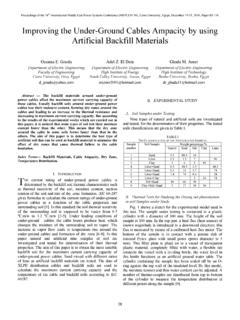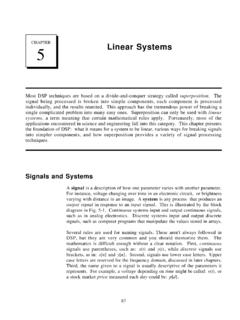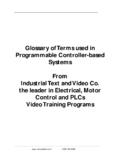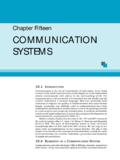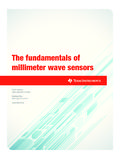Transcription of Transmission Line Faults Classification Using …
1 Proceedings of the 14th International Middle East Power Systems Conference (MEPCON'10), Cairo University, Egypt, December 19-21, 2010, Paper ID 225. Transmission line Faults Classification Using Wavelet Transform Hiyama Assistant Lecturer Aswan High Institute of Energy Department of computer science and electrical South Valley University Egypt Graduate School of Science and Technology PhD. Student-Graduate School of Science and Kumamoto University-Japan Technology, Kumamoto University-Japan Abstract- Power system fault identification Using information The DWT is easier to implement than Continuous conveyed by the wavelet analysis of power system transients is Wavelet Transform CWT because CWT is computed by proposed for detecting types of Transmission line Faults . The changing the scale of the analysis window, shifting the work presented in this paper is focused on identification of window in time, multiplying the signal and the information simple power system Faults .
2 Discrete Wavelet Transform of interest is often a combination of features that are well (DWT) analysis of the transient disturbance caused as a result localized temporally or spatially This requires the use of of occurrence Faults is performed. The maximum detail analysis methods sufficiently, which are versatile to handle coefficient, energy of the signal and the ratio of energy change signals in terms of their time-frequency localization.. of each type of simple simulated fault are characteristic in Frequency based analysis has been common since Fourier's nature and used for distinguishing fault types. time; however frequency analysis is not ideally suited for Index Terms Transmission line Faults , wavelets transform. transient analysis, because Fourier based analysis is based I. I. INTRODUCTION on the sine and cosine functions, which are not transients.
3 These results in a very wide frequency spectrum in the Electromagnetic transients in power systems result from analysis of transients Fourier techniques cannot a variety of disturbances on Transmission lines, such as simultaneously achieve good localization in both time and Faults , are extremely important [1] .A fault occurs when two frequency for a transient signal. [3].The main advantage of or more conductors come in contact with each other or WT over Fourier Transform is that the size of analysis ground in three Phase systems, Faults are classified as window varies in proportion to the frequency analysis. WT. Single line -to-ground Faults , line -to- line Faults , Double can hence offer a better compromise in terms of localization line -to-ground Faults , and Three phase Faults . [5]. For it is at such times that the power system components are subjected to the greatest stresses from excessive currents These Faults give rise to serious damage on power system equipment.
4 fault which occurs on Transmission lines not only effects the equipment but also the power quality. So, it is necessary to determine the fault type and location on the line and clear the fault as soon as possible in order not to cause such damages. Flashover, lightning strikes, birds, wind, snow and ice-load lead to short circuits. Deformation of insulator materials also leads to short circuit Faults . It is essential to detect the fault quickly and separate the faulty section of the Transmission line . Locating ground Faults quickly is very important for safety, economy and power quality. Wavelet theory is the mathematics, which deals Fig. 1. Analyses of signal Using wavelet transform with building a model for non-stationary signals, Using a set The wavelet transform decomposes transients into a series of components that look like small waves, called wavelets.
5 Of wavelet components, each of which corresponds to a It has become a well-known useful tool since its time domain signal that covers a specific octave frequency introduction, especially in signal and image processing [2]. band containing more detailed information. Such wavelet [3]. components appear to be useful for detecting, localizing, and classifying the sources of transients. Hence, the wavelet researcher acknowledge the financial support WAVELET TRANSFORM (DWT) given by the transform is feasible and practical for analyzing power Egyptian government (culture and mission section) for sponsoring this system transients [1-5]. 532. The discrete wavelet transform (DWT) is normally For the simulation [6-8] a simple power system network, implemented by Mallat's algorithm its formulation is related shown in to filter bank theory. Wavelet transform is largely due to this technique, which can be efficiently implemented by Using only two filters, one high pass (HP) and one low pass (LP) at level (k).
6 The results are down-sampled by a factor two and the same two filters are applied to the output of the low pass filter from the previous stage. The high pass filter is derived from the sample power system network wavelet function (mother wavelet) and measures the details Consisting of a generator (10 MVA kV, 60 Hz), in a certain input. The low pass filter on the other hand connected with a single Transmission line with resistance delivers a smoothed version of the input signal and is Ohm/km and reactance H/km and load derived from a scaling function, associated to the mother (PL= QL= ) were used and the simulation time wavelet. The idea is illustrated in Figure 2 which was at 50us and resistance fault equal 1ohm. mathematically is expressed as Three phase current signals at normal condition were recorded and decomposed Using DWT (db4 level 1) to get y high [ k ] = x [ n ].
7 H [ 2k n ] there maximum details coefficient, energy of these signals n and then making compression of these signals and take the ratio of energy change from the first level with keeping y low [ k ] = x [ n ].L [ 2k n ] approximation with no change because fault inception have n great effect on detail coefficient as it generate a high frequency component to signal. First Faults were created at a line for one cycle and analysis these signals before the realizing and switching of the circuit breaker. Different types of Faults were simulated Using MATLAB simulation [6] and after recorded transient signals they were decomposed Using wavelet toolbox to get there maximum details coefficient, energy of these signals and then making compression to these signals to get the ratio of energy DWT multi filter bank framework. change from the first level and how Faults make changes to In this work, results are carried out by Using the db4 as the energy of these signals.
8 Simulation was carried out for mother wavelet for signal analysis .The wavelet energy is all different single phase to ground fault but only shown the sum of square of detailed wavelet transform oefficients. here is Phase-A to ground all different double Phase with or The energy of wavelet coefficient is varying over different without ground are simulated and analyzed but only shown scales depending on the input signals. The energy of signal here are Phase-AB (double phase fault ) and AB-G (double is contained mostly in the approximation part and little in phase to ground fault ) and three phase Faults . [4]. the detail part-as the approximation coefficient at the first- Making compression of current signals Using threshold level contains much more energy than the other coefficients energy ratio with the first energy level for all current signals at the same level of the decomposition tree-but because the with keeping approximation with no change to compute the faulty signals have high frequency components, it is more threshold of energy ratio change which if any energy ratio distinctive to use energy of detail coefficients.
9 Exceed this ratio level this means that there is a faulty The basic algorithm for the DWT is not limited to dyadic condition to that phase. In our work if the energy ratio was length and is based on a simple scheme: convolution and exceed this phase is a faulty phase. down sampling. As usual, when a convolution is performed Secondly to decide if this double phase or double phase on finite-length signals, border distortions arise. to ground fault it was very cleared that if the fault is double In this work the extension of DWT is Symmetrization phase the energy ratio will be the same for these two faulty ( sym') this method assumes that signals can be recovered phases with comparison with the energy ratio of double outside their original support by symmetric boundary value faulty phases when there is double phase to ground fault although Symmetrization has the disadvantage of artificially these ratio were not same and were some different.
10 These creating discontinuities of the first derivative at the border results will be very cleared in next figures and tables. but it has a very small effect in calculation so the detail coefficients figured here show the signal end effects are III. fault CASES STUDY AND RESULTS. present, but the discontinuities are very well cleared A. Normal condition detected. Three phase current signals (A blue, B green and C red II. system STUDY AND WORK PROCESS colures) at no fault condition and there detail coefficient 533. are shown in figure 4 which indicate that when there are no this means that these phases were in fault condition fault the detail coefficient of these signals are near to reach and when making compression the amount of energy zero(straight line ) and only appear the ending effect of sym. change for two faulty phase were different not in same wavelet which also very small and near zero (1*10-3) and amount this will indicate that these faulty phases were the energy of each signals are present in table (1) and the connected to the ground.
